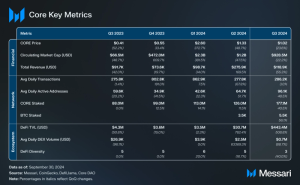Key Insights
- APE token price grew by 41%, and the APE market cap grew by 53% QoQ. Sell pressure from an extra 24.8 million APE unlocked to non-DAO entities did not lead to a drop in APE price.
- ApeCoin DAO voted to cut Special Council pay in half for newly elected members, which will save the DAO roughly $375,000 in 2024.
- APE token transfers fell to their lowest level in a year. The 30%QoQ drop indicates that traders are holding APE more than in previous quarters.
- Dolphins ($500,000 – $1 million in daily trading) and seals ($100,000 – $500,000 in daily trading) grew their share of APE DEX trade volume to a collective 43%, overtaking whales (over $10 million in daily trading) and lessening whale influence in DEX trading volume of the APE token.
- ApeCoin DAO voted to fund $1.6 million in grants during Q4, down 92% QoQ. This shows the DAO’s move to be more selective about how it spends its treasury.
Primer
ApeCoin (APE) is an ERC-20 token used for governance of the ApeCoin DAO. Holding any amount of APE qualifies the holder as an ApeCoin DAO member. Members create and vote on ApeCoin Improvement Proposals (AIPs) that encompass Ecosystem Fund distribution, governance rules, partnerships, and more. Third-party developers can incorporate APE into their respective projects.
APE is the adopted token of the APE Foundation, a legal entity that administers the decisions of the ApeCoin DAO. The APE Foundation also has a Special Council, called the DAO’s Board, to perform certain functions within the governance process. The operations of the APE Foundation are run by transient administrative entities elected by members of the ApeCoin DAO.
The ApeCoin DAO and the APE Foundation are separate entities from Yuga Labs, the creator of the Bored Ape Yacht Club (BAYC) and associated NFTs. Below is a breakdown of the relevant entities associated with the APE token.
- ApeCoin DAO — A decentralized autonomous organization (DAO) made up of APE holders that create and vote on AIPs.
- APE Foundation — A legal entity that administers the decisions of the ApeCoin DAO.
- Special Council (the DAO’s Board) — Five individuals who oversee the APE Foundation’s administrators, can approve grants outside of the AIP process, and perform certain functions within the ApeCoin DAO governance process. The current Special Council members are Bored Ape G, Waabam, CaptainTrippy, Hazel, and Airvey.
- WebSlinger — Current administrator of the APE Foundation; started its 12-month renewal agreement on March 1, 2023.
- Cartan Group — The first and former administrator of the APE Foundation.
- Yuga Labs — A Web3 company responsible for creating the Bored Ape Yacht Club (BAYC). Yuga Labs is a contributor to ApeCoin and plans to use APE as the primary token in future projects like Otherside.
The APE Foundation, the DAO’s Board, and WebSlinger are the primary entities that ensure the implementation of relevant passed ApeCoin DAO proposals (AIPs).
Key Metrics
Performance Analysis
Market Cap
Market cap measures the price of the asset multiplied by the circulating supply. Changes in market cap give a nuanced view of the value traders prescribe to an asset with a changing supply at a given moment.
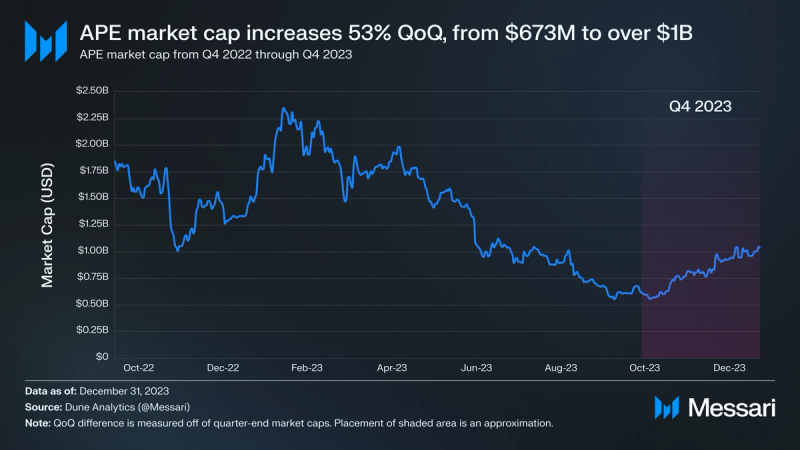
APE’s market cap increased by 53% QoQ despite consistently falling throughout the past year. The valuation of the general crypto market also increased by 53% throughout the quarter. APE’s market cap ended Q4 valued at over $1 billion. A large portion of the market cap increase came from APE’s price rising by 41% QoQ. The remaining increase in market value came from the unlock of 46.8 million APE included in the circulating supply.
Additionally, the ApeCoin DAO spent roughly 8% ($1.6 million) of what it spent in the previous quarter ($20.3 million), reducing the amount of tradable APE committed through governance. In Q4, Yuga Labs’ ApeCoin-adjacent NFT assets also rose in floor price between 7–26%.
APE Liquid Supply
Liquid supply curves help determine when an increase in sell pressure may occur for certain assets (or when tokens may get dumped onto unsuspecting buyers). Specifically, they show when tokens unlock and to whom.
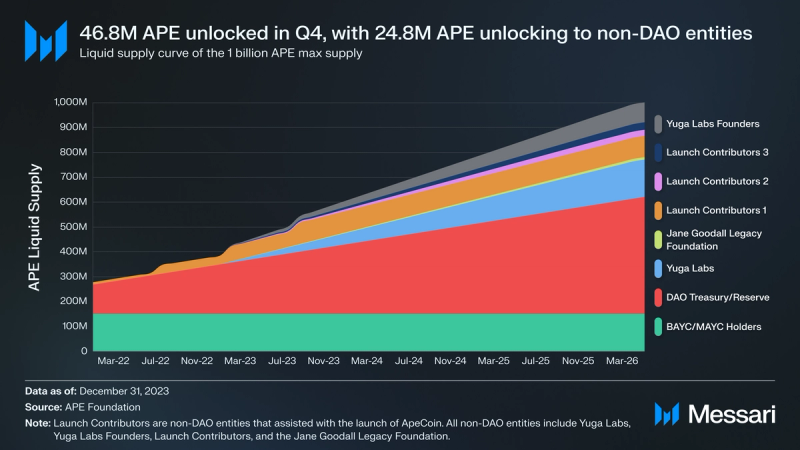
An additional 46.8 million APE (9% of the Q3 circulating supply) was unlocked in Q4 2023. Of this, 22 million APE went to the DAO Treasury and 24.8 million APE went to non-DAO entities. The DAO issues or sells APE to fund DAO proposals contingent on them being passed. Alternatively, non-DAO entities are free to sell once their funds are unlocked. Despite the sell pressure of an additional 24.8 million APE, the price of APE increased by 41% throughout the quarter.
Claimed Staking Rewards
ApeCoin DAO started to issue staking rewards in Q4’22 after passing AIP-21 and AIP-22, which finalized staking parameters. APE holders and Yuga Labs’ ecosystem projects like Bored Ape Yacht Club (BAYC), Mutant Ape Yacht Club (MAYC), and Bored Ape Kennel Club (BAKC) received staking allocations.
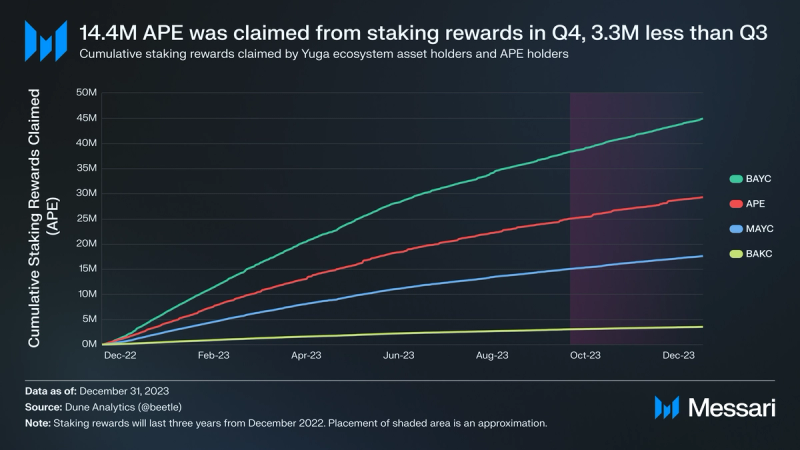
Staking was implemented in early December 2022 and will last for three years. It will ultimately distribute 175 million APE (17.5% of the max supply) to Yuga ecosystem asset and APE holders. Since staking launched, the amount of APE claimed has decreased every quarter. In Q4, 14.4 million APE was claimed, 19% less than the previous quarter.
However, APE is still being claimed, compounding the sell pressure from unlocks to non-DAO entities. As many assets began to recover in Q4, this extra sell pressure did not stop the APE market cap from increasing by 53%. Other metrics like average swap size and transfer volume decreased QoQ, potentially signaling that more APE traders are holding APE going into 2024.
Volume by Trade Size
Volume by trade size shows the percentage of the trading volume corresponding to various trade sizes. For example, if the total volume were $200 million and two wallets traded $50 million each (a total of $100 million), then the two wallets with a volume of $50 million each (a combined $100 million) would account for 50% of the trading volume.
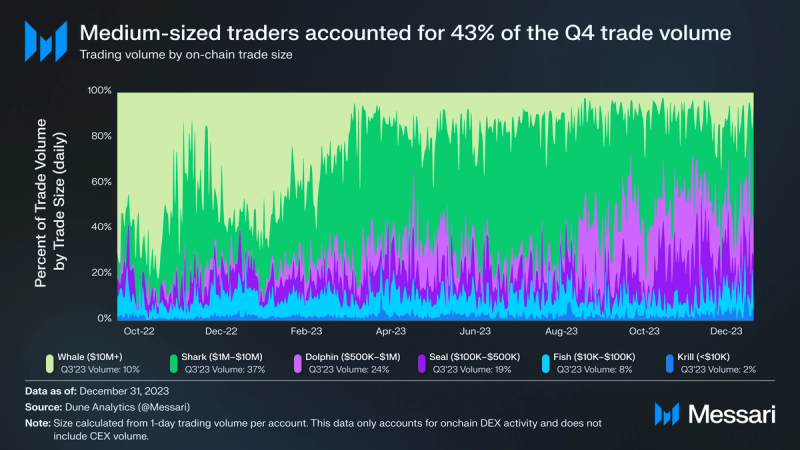
Over the past year, the trade volume has shifted from whales (accounts with 1-day trading volumes greater than $10 million) to sharks (between $1 million and $10 million). In Q3, sharks accounted for 54% of the APE trade volume, after increasing for four consecutive quarters. Q4 marks a shift in dominance from sharks to medium-sized traders like dolphins (between $500,000 and $1 million) and seals (between $100,00 and $500,000). In general, the downward shift in volume from whales to sharks and now to medium-sized traders may indicate a stronger desire to hold the asset among large holders.

In Q4, medium-sized traders collectively overtook sharks, accounting for 43% of APE’s DEX trading volume. Even after accounting for more than half of the volume in the previous quarter, shark volume fell to 37%. Despite a 41% rise in the price of APE, the average DEX swap size fell by 9%, continuing the downward trend of average swap size. A smaller average swap size may indicate that bigger APE traders are holding the asset for longer or that they are migrating to centralized exchanges (CEXs).
The above data only includes onchain activity, not CEX trades. As such, its metrics may not show the full picture, given that higher volume traders may be more inclined to use CEX platforms because they usually offer assurances, protections, and incentives. For example, institutional traders often prefer to have access to advanced tools and technical support on CEXs. Additionally, CEXs are not subject to sophisticated MEV strategies like sandwich trading, which is prevalent on DEXs but can be mitigated by using DEX aggregators like Matcha.
Token Velocity
Token velocity shows the frequency through which an asset changes hands (or wallets). A change in token velocity can show a few things depending on the asset. If the asset can be used beyond trading, such as a token used within a game, an increase in token velocity may imply that the game encourages the adoption/use of the asset. If the asset is more speculative, then a decrease may imply that users are more interested in holding the asset or that it has low demand. In the chart below, token velocity is calculated by dividing the circulating supply by the seven-day moving average (7DMA) of transfer volume.
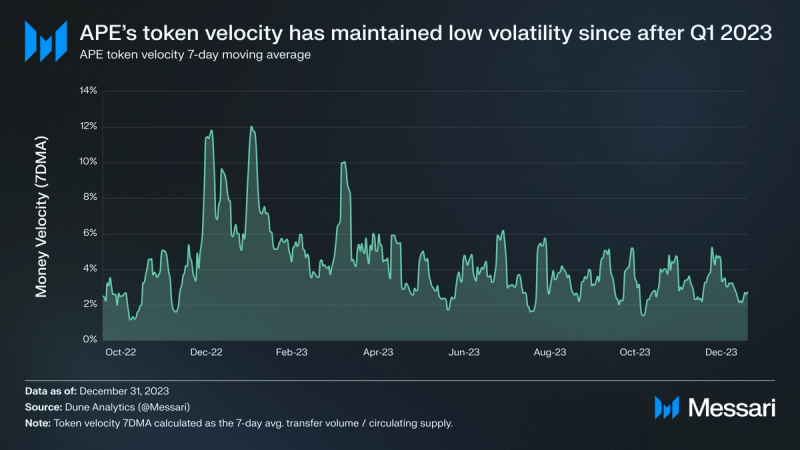
The average transfer velocity fell from 3.6% to 3.3% QoQ. The steady decline and low volatility may be indicative of existing holders actively using the asset for governance. As APE holders anticipate the pending launch of the Otherside game — which will use APE as an in-game currency — the use cases for APE remained unchanged in Q4.
The number of proposals has increased for the past four quarters. This requires more active use of the APE token in governance than previous quarters. The continuously increasing governance proposals appear to be inversely related to token velocity and may contribute to the lower volatility of token movement than from previous quarters. Token velocity will be expected to increase as Otherside launches and APE is used for in-game transfers. As the ApeCoin DAO seeks more economical alternatives to Ethereum in launching its own chain, it also anticipates token movement to increase after introducing lower gas costs for users.
New APE Holders
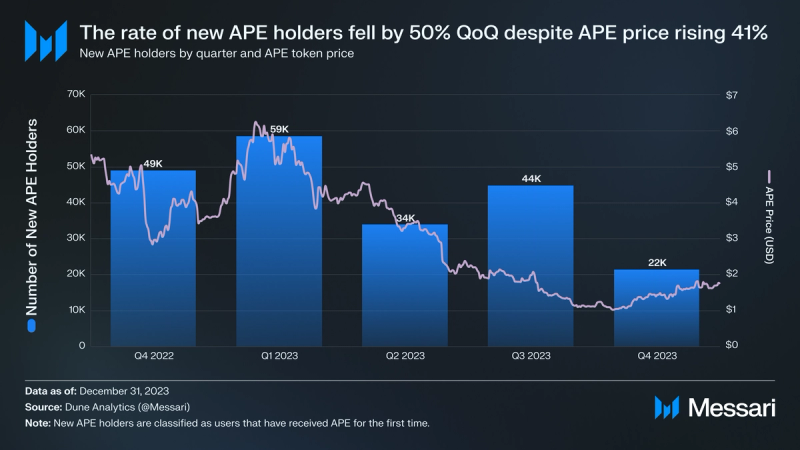
New APE holders are defined as addresses receiving APE for the first time. This metric does not include any new holders using centralized exchanges to custody their assets. The inflow of new APE holders decreased by 52%, despite the APE price rising by 41%. Although the number of holders tends to follow price action, there does not appear to be a correlation between new APE holders and price over the past three quarters. The ApeCoin DAO is aiming to raise community awareness and engagement through the approvals of AIP-301, AIP-314, AIP-335, and AIP-348. These proposals cover topics such as producing educational materials about the DAO, publishing media related to the DAO, and other community engagement initiatives.
Unique Votes per Proposal
Unique votes per proposal measure how many individuals are participating in governance. If new voters only hold small amounts of an asset, then the impact of their unique votes would be marginal on proposal outcomes in token-weighted governance systems like ApeCoin DAO. However, counting unique votes can show the interest within a DAO, diversity of the active holder base, and decentralization of the active holder base.
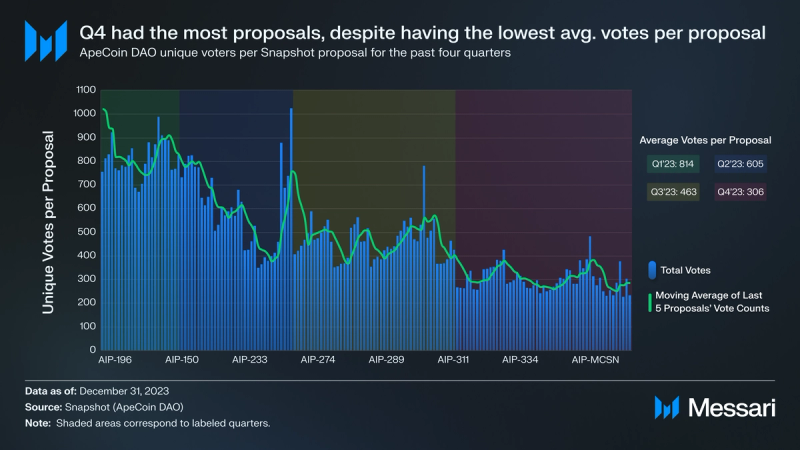
During Q4, ApeCoin DAO had the largest number of proposals within any quarter, voting on 53 proposals. Despite the activity in the form of proposals, the average unique voters per proposal dropped to 306, a 34% fall QoQ. Compared to the previous quarter, the amount of funding promised fell by 92%, from $20.3 million to $1.6 million. This drop indicates that the DAO is being more conservative with the proposals it approves as the price of the treasury’s primary asset increases in value.
In the future, ApeCoin DAO plans to move more of the voting process onchain. Doing so would remove central points of failure (like the reliance on Snapshot) and would add to the governance structure’s decentralization. However, implementing onchain voting would require gas fees for participation. For this reason among others, the DAO is contemplating building a separate ApeCoin chain (ApeChain) that would use APE as the native gas token and would be less expensive than Ethereum. After this move, the DAO would be in a better position to fully transition governance onchain.
Governance Analysis
Throughout Q4 2023, ApeCoin DAO voted on 53 proposals: 11 passed, 32 failed, and 10 were either elections or multiple choice. The failed AIPs proposed costs for implementation totaling $57.4 million (with one failed AIP requesting a reallocation of 10% of the total treasury to ETH and USDC). The total value of passed proposals and elections was $1.6 million. Eight election proposals were held throughout Q4: four nominations and four concrete elections. The election proposals determined the following positions and their compensation:
- Three new Special Council members (compensated at $125,000 each for a one-year term)
- One new Governance Working Group Steward (compensated at $108,000 for a one-year term)
- Two new Metaverse Working Group Stewards (will propose a budget in January 2024)
- Two new Marketing and Communications Working Group Stewards (will propose a budget in January 2024)
The ApeCoin DAO Q3 2023 Transparency Report was published in December. The report shows that the ApeCoin DAO’s holdings could be broken down as follows (with a Dec. 1, 2023 APE price of $1.62):
- Treasury: 370 million APE ($599.4 million)
- Owes in Accounts Payable: 205,279 APE ($332,552)
- Reserved for Grants: 96 million APE ($155.5 million)
Listed below are five proposal highlights from the quarter in order from newest to oldest. For a full overview of ApeCoin governance, including preliminary discussions, see the Messari Governor page on ApeCoin.
AIP-373: Boring Security
Dec. 27, 2023
In AIP-373, Boring Security requested funds to support its operations and growth while committing to enhance the visibility and reputation of ApeCoin through branding, educational initiatives, and community engagement. It plans to deploy the funds into a Uniswap V3 Liquidity Pool. The yield generated from this pool would then be used for structured withdrawals to cover its operating expenses not met by partnership income and other grants. ApeCoin DAO approved $239,000 to fund this operation, making it the second-most expensive AIP approved in Q4.
Special Council Elections
Dec. 20, 2023
Three seats opened up for Special Council elections in Q4. These seats were occupied by Bored Ape G, Gerry, and Vera Li. Bored Ape G ran for reelection and won along with two new Special Council members, Hazel and Airvey. Each will be compensated at $125,000 for a one-year term. This does not add any additional costs to the ApeCoin DAO. Starting on January 2024, the five Special Council members will be Waabam, CaptainTrippy, Bored Ape G, Hazel and Airvey.
AIP-346: Token-Gated Stand-Up Comedy
Nov. 22, 2023
In a narrow victory, APE holders voted to implement AIP-346, which proposes in-person and live-streamed comedy shows exclusively for APE holders. Committed funds will be used by Laughing Ape, Inc. to cover costs related to event hosting, talent, technology, production, and marketing. Holders only need at least one APE to be eligible for related events. ApeCoin DAO approved $180,000 to fund this operation, making it the third-most expensive AIP approved in Q4.
AIP-350: Special Council Pay Adjustment
Nov. 1, 2023
ApeCoin DAO’s Special Council used to receive roughly $20,833 per month ($250,000 per year) per member. With five members, this cost the DAO $1.25 million a year. In AIP-350, with three options (one keeping the status quo), APE holders voted to cut pay in half for new Special Council members. Starting January 2024, the three new Special Council members will be paid $125,000 per year each — with the two existing members finishing their terms at $250,000 per year each.
Back in October, AIP-337 aimed to enact a similar measure that would have cut the Special Council pay in half, but it narrowly failed. After a bit over a month, sentiment changed among APE holders, ultimately pushing for the new pay structure.
AIP-326: Payment Platform
Nov. 1, 2023
With 66% support, APE holders voted to approve AIP-326. With this proposal, CR3 Labs and Vora Labs aim to create a low-code platform that would enable mobile and web game developers to implement APE-powered payments and rewards for games. The vision of this platform is to simplify the onboarding of games into crypto. In particular, it focuses on enabling builders to implement APE rewards and payments via the platform. ApeCoin DAO approved $480,000 to fund this operation, making it the most expensive AIP approved in Q4.
Closing Summary
In Q4 2023, ApeCoin DAO’s flagship APE token grew in price, increasing 41% QoQ. Daily average token transfers hit their lowest level in a year, indicating that traders are holding APE more than in previous quarters. Given APE has yet to be implemented as a payment token, this decrease in velocity may be positive for maintaining the value of the asset. Additionally, medium-sized APE traders have become dominant in the DEX landscape, overtaking the volume of whale-sized traders.
While the average votes per governance proposal continued to decline, Q4 saw the largest number of proposals, with four pertinent election topics: Special Council elections and working group elections for governance, metaverse, and marketing/communications. ApeCoin DAO has shown its ability to cut spending, decreasing Special Council salaries and approving under $2 million in Q4, compared to $20.3 million in the previous quarter. Although the DAO still approved funding for some proposals of questionable value-add, it appears to be moving in a more selective direction for funding future initiatives.

